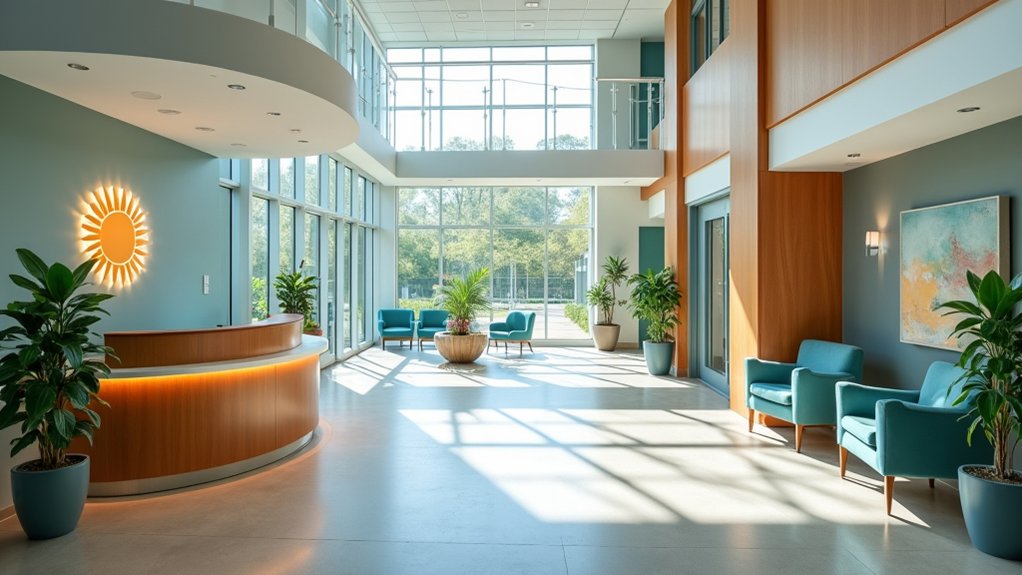In 2025, you’ll have access to extensive addiction recovery services including outpatient counseling, 24-hour residential programs, and FDA-approved medications like buprenorphine and naltrexone that reduce cravings. AI-powered platforms now personalize your treatment using real-time data from wearable devices monitoring sleep and stress patterns. Telehealth services expand access to specialized therapies combining cognitive behavioral therapy with mindfulness approaches. With over 2.3 million Americans receiving medication-assisted treatment, evidence shows 90-day programs greatly improve your recovery outcomes and long-term stability.
Outpatient and Inpatient Treatment Program Options

When selecting addiction treatment services in 2025, you’ll encounter two primary pathways: outpatient and inpatient programs, each designed to meet distinct clinical needs and recovery circumstances. Outpatient services offer flexibility through individual counseling, group sessions, and office-based opioid treatment, allowing you to maintain daily responsibilities while receiving care. Inpatient programs provide 24-hour supervision in residential facilities, incorporating medical withdrawal management and clinical stabilization services. Research demonstrates that treatment stays of at least 90 days markedly improve recovery outcomes, with longer durations enhancing sobriety rates and life stability. Treatment facilities now develop personalized care plans that are tailored to address individual patient needs and circumstances throughout the recovery process. Following primary treatment, supportive transitional programs facilitate safe community reintegration, while peer recovery communities offer structured sober living environments that connect you with employment resources and self-help networks essential for sustained recovery. Many programs incorporate Twelve Step principles as a spiritual foundation for creating sober communities and mutual support systems.
Medication-Assisted Treatment and Pharmacotherapy Services
If you’re struggling with opioid or alcohol use disorder, medication-assisted treatment (MAT) offers evidence-based pharmacotherapy options that drastically improve your chances of sustained recovery. You’ll have access to FDA-approved medications like buprenorphine and methadone for opioid addiction, or naltrexone and acamprosate for alcohol dependency, all designed to reduce cravings and normalize brain chemistry. Thanks to 2025’s expanded telehealth services and office-based prescribing, you can now access these life-saving treatments more conveniently than ever before. Advanced genetic testing now helps determine which medications will work best for your specific biochemistry, creating truly personalized treatment plans that significantly improve your odds of long-term success. MAT is recognized as the gold standard of care for opioid use disorder because it not only reduces opioid use and overdose risk, but also decreases criminal activity and infectious disease transmission while improving your social functioning and treatment retention.
MAT for Opioids
Medication-assisted treatment (MAT) stands out as the most effective evidence-based approach for opioid use disorder, yet fewer than one in five people who need it actually receive these life-saving medications. You’ll find three FDA-approved options available: methadone, buprenorphine, and extended-release naltrexone, each offering distinct benefits for your recovery journey.
These medications dramatically reduce overdose risk and all-cause mortality when you remain in treatment. However, medication adherence challenges persist due to stigma and regulatory barriers, while provider training needs limit access in many communities. Unfortunately, demographic disparities exist in treatment access, with Black and Hispanic adults receiving medications at lower rates than White adults. MAT programs operate through outpatient clinics, specialized addiction centers, and primary care settings, with research showing $12-$14 in savings for every dollar invested in your treatment. With 8.9 million Americans aged 12 and older misusing opioids at least once over a 12-month period, the need for expanded MAT access becomes increasingly urgent. Given that treatment for opioid dependence is often lifelong due to the chronic nature of the condition, continuous support remains essential for maintaining recovery.
Alcohol Treatment Medications
Three FDA-approved medications form the cornerstone of evidence-based alcohol use disorder treatment: naltrexone, acamprosate, and disulfiram. Your healthcare provider will select the most appropriate option based on your liver function and medical history. Naltrexone reduces cravings and relapse risk but requires caution with liver disease. Acamprosate offers excellent safety for those with liver disease complications due to renal metabolism. Disulfiram creates adverse reactions with alcohol but isn’t recommended for liver disease patients.
- Gabapentin helps reduce withdrawal symptoms and prevents relapse
- Topiramate decreases heavy drinking days in hazardous drinkers
- Baclofen provides an option for patients with liver complications
Your treatment team will implement liver function monitoring and medication dose adjustments throughout therapy. These evidence-based pharmacotherapies extensively improve recovery outcomes when combined with all-encompassing care. Research shows that combining pharmacological and behavioral approaches may yield more effective treatment results than using medications alone. Despite their proven effectiveness, these medications remain significantly underutilized, with only 1.3% of Medicare beneficiaries receiving treatment after hospital admission for alcohol use disorder. Recent studies demonstrate that AUD medication prescribing leads to reduced 30-day rehospitalization for alcohol-related complications.
Expanding Access Trends
Recovery services are undergoing a transformative shift as medication-assisted treatment (MAT) programs expand nationwide, offering you unprecedented access to evidence-based pharmacotherapy. Over 2.3 million Americans received MAT in 2023, with retention rates reaching 75% at one year for buprenorphine treatment. States are aggressively expanding Medicaid coverage and insurance reimbursement, directly addressing underserved population needs that previously faced financial barriers.
Policy reforms now mandate MAT availability in correctional facilities and public health settings by 2025. Despite this progress, geographic disparities in access remain challenging; only 14.6% of individuals with substance use disorders currently receive treatment. Rural and urban communities benefit from flexible MAT protocols that integrate behavioral therapies, while prescription drug monitoring programs guarantee safer prescribing practices and improved provider expertise through mandatory training requirements. Access to MAT medications in correctional facilities reduces fatal overdose risk by nearly 32% post-release, demonstrating the critical importance of continuity of care. MAT significantly reduces overdose risk by 34-38% compared to no treatment.
Virtual Care Platforms and Technology-Driven Solutions
You’ll find that AI-powered algorithms can now analyze your unique recovery patterns, treatment history, and physiological data to create highly personalized intervention strategies that adapt in real-time to your changing needs. Wearable devices continuously monitor your heart rate variability, sleep quality, and stress indicators, providing your care team with objective data to identify potential relapse triggers before they escalate. Virtual programs have proven particularly effective for individuals with mild to moderate substance use disorders, while severe cases may still require more intensive in-person interventions. These platforms deliver comprehensive care through medically assisted treatment that addresses both addiction and co-occurring mental health conditions with appropriate medications when needed. This technology-driven approach guarantees you receive precisely calibrated support when you need it most, transforming addiction recovery from a reactive process into a proactive, data-informed journey.
AI-Powered Personalized Treatment
Revolutionary advances in artificial intelligence are transforming addiction recovery through personalized treatment algorithms that analyze your detailed health data, behavioral patterns, and treatment history to create truly individualized care plans. These AI-driven recovery coaching systems continuously adapt interventions based on your treatment response and relapse risk assessment, ensuring ideal therapeutic outcomes.
Machine learning models provide clinical decision support, recommending evidence-based therapies tailored to your specific needs. The technology considers social determinants, co-occurring disorders, and environmental triggers for thorough care planning.
- Predictive analytics identify early warning signs of relapse before symptoms manifest
- Real-time monitoring tracks engagement levels and behavioral changes instantly
- Dynamic plan updates modify treatment strategies based on your progress data
Integration with community-based social support programs creates seamless care coordination, enhancing long-term recovery success through data-driven precision medicine approaches.
Wearable Health Monitoring
Building on AI-powered treatment algorithms, wearable health monitoring devices now provide continuous, objective data streams that transform how you and your care team track recovery progress in real-time. These sophisticated sensors monitor heart rate variability, sleep patterns, stress levels, and even transdermal alcohol content, enabling biometric-based relapse prevention strategies that respond before crisis points emerge.
| Monitoring Type | Technology | Clinical Application |
|---|---|---|
| Alcohol Detection | Transdermal sensors | Real-time relapse identification |
| Stress Recognition | Heart rate variability | Early intervention triggers |
| Sleep Quality | Advanced accelerometry | Recovery pattern optimization |
| Physical Activity | Multi-sensor tracking | Treatment adherence monitoring |
| Vital Signs | Thorough biosensors | Health status assessment |
Continuous monitoring effectiveness stems from immediate alerts sent to your treatment team when biometric anomalies suggest heightened relapse risk, enabling prompt interventions.
Specialized Therapies and Emerging Treatment Approaches

The landscape of addiction recovery has transformed dramatically with specialized therapies that target both the neurobiological and psychological dimensions of substance use disorders. You’ll find that GLP-1 medications like semaglutide now reduce cravings across multiple substances by modulating brain reward pathways. Advanced Medication-Assisted Treatments employ precision dosing and pharmacogenomics for safer, more effective withdrawal management.
Community-based holistic programs integrate mindfulness, yoga, and nutritional counseling to support whole-person healing. Personalized wellness interventions combine these approaches:
- Mindfulness-Oriented Recovery Enhancement (MORE) merging CBT with positive psychology
- Trauma-informed DBT for co-occurring mental health disorders
- AI-powered digital therapeutics providing 24/7 support and monitoring
These evidence-based treatments recognize that your recovery journey requires both cutting-edge medical interventions and compassionate, individualized care addressing underlying trauma and emotional regulation challenges.
Treatment Success Rates and Recovery Outcomes
When you’re considering addiction treatment, understanding realistic success rates helps set proper expectations for your recovery journey. You’ll find that 42% of patients complete initial treatment, with 36% maintaining recovery through the first year. While 75% experience relapse during year one, your risk drops markedly over time, below 15% after five years of sobriety.
Long-term sobriety outcomes vary by substance type, with alcohol showing 41% one-year success rates compared to 29-31% for fentanyl and heroin. The recovering population characteristics that predict success include individualized treatment approaches, supportive family relationships, and dual mental health care integration. You’re most vulnerable during the initial 90 days, but sustained recovery becomes increasingly achievable with proper support systems.
National Treatment Facility Landscape and Accessibility

Access to quality addiction treatment depends heavily on where you live, as the nation’s 17,808 substance abuse clinics are unevenly distributed across states and regions. While populous states host the most facilities, one-third of states provide fewer than 25 substance use treatment beds per 100,000 people, compared to others offering up to 79 beds.
You’ll face significant barriers accessing care due to:
- Facility capacity constraints limiting available treatment slots nationwide
- Workforce shortages reducing service availability and quality
- Financial barriers, with only 443 facilities offering completely free treatment
Despite serving 1.46 million patients annually, the system struggles with declining psychiatric bed supply and regional disparities. Your treatment options vary dramatically by location, making geographic accessibility a critical factor in recovery planning.
Frequently Asked Questions
How Much Does Addiction Treatment Cost and What Insurance Coverage Is Available?
Addiction treatment costs vary extensively; you’ll pay $1,500-$10,000 monthly for outpatient programs and $5,000-$80,000 for residential care. However, thorough insurance coverage is available. ACA-compliant plans include substance use disorder services as essential benefits, while Medicaid coverage encompasses outpatient, inpatient, and medication-assisted treatment. Your out-of-pocket expenses depend on deductibles and copays, but Medicaid coverage often minimizes costs for FDA-approved medications, making recovery financially accessible.
What Are the Typical Waiting Times to Get Into Treatment Programs?
You’ll typically face waiting times of several weeks to months for treatment programs, with 40% of people dropping off waitlists within two weeks. Treatment program accessibility varies markedly; private facilities offer shorter waits but cost more, while publicly funded options have longer delays due to limited rehabilitation facility capacity. Staff shortages and insurance approval processes further extend waits. Unfortunately, 45% of individuals abandon treatment plans entirely due to excessive waiting periods, making immediate action vital.
How Do I Choose the Right Treatment Facility for My Needs?
Choose your treatment facility by first completing an extensive biopsychosocial assessment using ASAM Criteria to determine your appropriate care level. Research program options that match your specific needs, whether outpatient counseling or residential care. Verify staff credentials, CARF or Joint Commission accreditation, and evidence-based treatment modalities like MAT or trauma-informed care. Consider practical factors, including location, insurance coverage, specialized services for dual diagnosis, and facilities demonstrating successful outcomes for populations similar to yours.
What Support Services Are Available for Families of Addiction Patients?
You’ll find extensive support through family counseling programs that include therapy sessions, educational workshops, and communication skill-building. Respite care services offer temporary relief when you’re overwhelmed. Peer-led groups like Al-Anon and Nar-Anon provide shared experiences and mutual support. These evidence-based interventions help 78% of families improve their well-being while learning healthy boundaries, coping strategies, and relapse prevention techniques that strengthen your family’s resilience throughout recovery.
Can I Continue Working or Going to School During Treatment?
Yes, you can often maintain work obligations and educational commitments during treatment through outpatient programs, IOPs, and telehealth options designed around your schedule. Many employers offer EAPs and flexible arrangements, while schools provide specialized counselors and academic accommodations. ADA and FMLA protections support your job security during recovery. However, intensive inpatient programs typically require full-time commitment, and some facilities face waitlists that could affect accessibility.







